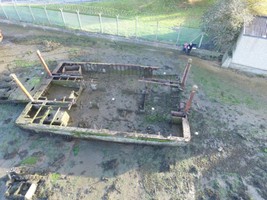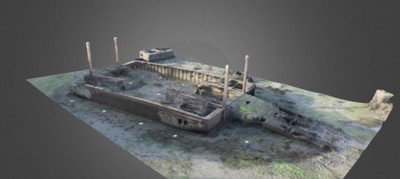Chain ferry
Chain ferry (82647)
- Easting
- 461193
- Northing
- 100748
Remains of a late 19th century former chain ferry that operated on the Medina River, Isle of Wight between 1896 and 1909. The current remains consist of the basic hull form, one of the two boarding ramps, the four posts of the lifting gear, the chain ways and two water tanks. Overall length is 14.4 m, beam is 8.93 m, total height is 4.5 m and depth off hull 1.56 m. The hull is made from iron fastened with iron bolts, the deck is constructed from wood and the boarding ramp from wood and iron. Most of the hull is still present and has preserved and has some structural integrity, though heavily corroded. Only a small fragment of the wooden deck survives on the port bow corner (Beattie-Edwards and Satchell 2011, 32).
The Medina River chain ferry was built to cross the Medina river on the Isle of Wight and operated between 1896 and 1909. Dubbed a ‘Floating Bridge’ it was built by William White and Sons at the Vectis Works in Cowes in 1896. It was replaced in service and remained in Cowes as a spare floating bridge until 1925. It was then owned by boat designer Uffa Fox who bought it for £150 who converted it into a workshop and accommodation, it became known as ‘Summer Bridge’. He built a roof over the central part to make the workshop and used the ramp as a gangway to the shore with the other used as a slipway to launch boats. The boiler and steam engine were removed and the space used to create an office and a bedroom. The passenger cabins were converted into a kitchen and another bedroom on one side and a dining room and drawing room on the other side. It was sold and moved to Forton Lake in 1948 where it was stripped for parts.
Surveyed as part of the Forton Lake Archaeological Project between 2006-2009 NAS survey reference: FL11 AHBR: 53074
The vessel was subject to a drone survey in November 2016 by CITiZAN and local resident Stuart Fitt, the model is available online https://sketchfab.com/models/bcfbb53e2781490cb9160c79f46c9abf
- Period
- Modern (1901 and later)
- Period comments
Constructed by William White and Sons at Vectis Works, Cowes in 1896. Operated as a chain ferry between 1896 and 1909. Following its replacement in 1909, the ferry remained in Cowes as a spare 'floating bridge' until 1925.
- The earliest date of the feature, as a year, if known
- The latest date of the feature, as a year, if known
- Monument Type - Broad
- Watercraft
- Monument Type - Narrow
- Monument Description
- Evidence Type - Broad
- Vessel
- Evidence Type - Narrow
- Evidence Description
- Object Type - Broad
- Object Type - Narrow
- Object Description
- Height OD (m)
- 4.50
- How accessible is the feature?
- Accessible on foot (no footpath)
- Accessibility comments
Access is restricted at high tide but straightforward at other states of the tide. The mud on which the vessel sits becomes slightly deeper on the northern (lake) side of the vessel but does not inhibit access.
Other records:
- NRHE Number
- 1526681
- NT HBSMR Number
- Unknown
- HER Event Number
- 53074
- External Link
- None
Over to you...
If you know there are errors in the original feature record above, you can edit the original record
If you would like to visit the feature and carry out a 'Feature Update Survey', you can prepare a 'Feature Update Survey' pack for this feature (in PDF format)
If you have completed a 'Feature Update Survey' for this feature, you can submit your 'Feature Update Survey'
If you want to use your smart phone to carry out the 'Feature Update Survey', you can download the CITiZAN smart app.
Feature Update Surveys
1 survey accepted and 0 pending.
Click on a survey to expand it.
- Date of survey
- 13th November, 2016
- Feature located?
- Yes
- State of the tide
- Low
- Proximity to coast edge
- Intertidal zone
- Coastal processes
- Active sea erosion
- Is there a coastal defence?
- No
- Other threats?
- Structural damage/decay
- If other, please specify
- How visible are the remains? ABOVE GROUND
- Highly visible (substantial remains)
- How visible are the remains in the face of the cliff, ridge or dune? IN SECTION
- Do you know if the feature is?
- Is well known, Is well visited, Has local associations/history
- What actions (if any) would you recommend for this feature?
The vessel is slowly deteriorating, recommend continued monitoring.
- Do you have any other comments?










